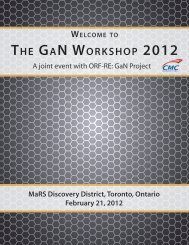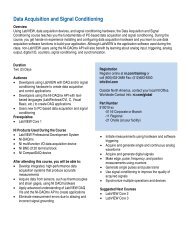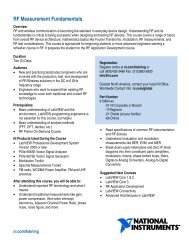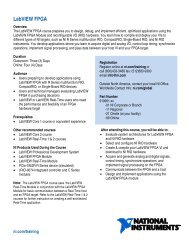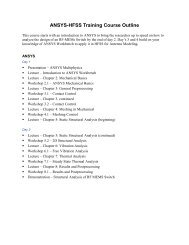High-Throughput LabVIEW FPGA Course Outline
High-Throughput LabVIEW FPGA Course Outline
High-Throughput LabVIEW FPGA Course Outline
You also want an ePaper? Increase the reach of your titles
YUMPU automatically turns print PDFs into web optimized ePapers that Google loves.
<strong>High</strong>-<strong>Throughput</strong> <strong>LabVIEW</strong> <strong>FPGA</strong> <strong>Course</strong> <strong>Outline</strong><br />
• Architect high-performance <strong>FPGA</strong>-based<br />
systems<br />
• Follow NI-recommended development and<br />
debug processes for efficient <strong>FPGA</strong><br />
implementation<br />
Suggested Next <strong>Course</strong>s<br />
• NI FlexRIO<br />
Day 1<br />
Graphical Design in <strong>LabVIEW</strong> <strong>FPGA</strong><br />
The goal of this section is to provide insight into <strong>FPGA</strong><br />
hardware resources, and how <strong>LabVIEW</strong> code maps to<br />
these resources in terms of size and propagation<br />
delay/loop rate. Topics include:<br />
• Introduction to <strong>FPGA</strong>s<br />
• Mapping <strong>LabVIEW</strong> primitives to <strong>FPGA</strong><br />
resources<br />
• Execution time/propagation delay/critical<br />
path/loop rate/clock rate<br />
• <strong>Throughput</strong><br />
Host Communication with <strong>LabVIEW</strong> <strong>FPGA</strong> through<br />
NI-RIO<br />
This lesson covers the methods of interacting between<br />
host and <strong>FPGA</strong> VIs. Topics include:<br />
• Memory-mapped register access<br />
• DMA<br />
• Interrupts<br />
• Interactive and programmatic <strong>FPGA</strong> VI<br />
execution<br />
I/O in <strong>LabVIEW</strong> <strong>FPGA</strong><br />
There are many methods of connecting the <strong>LabVIEW</strong><br />
<strong>FPGA</strong> VI to other logic on the <strong>FPGA</strong> as well as I/O<br />
outside the <strong>FPGA</strong>. Topics include:<br />
• User CLIP<br />
• Socketed CLIP<br />
• Importing HDL into CLIP<br />
• Target I/O<br />
• Synchronous and asynchronous I/O<br />
• Metastability and glitching, synchronization<br />
registers<br />
Day 2<br />
Crossing <strong>FPGA</strong> Clock Domains<br />
Large applications often involve logic running at multiple<br />
rates. There are specific considerations for exchanging<br />
data between these “clock domains.” Topics include:<br />
• Use cases for multiple clock domains<br />
• Global and Local Variables<br />
• Handshaking<br />
• FIFOs<br />
• 2 and 4-wire handshaking introduction<br />
• Memory items<br />
<strong>LabVIEW</strong> <strong>FPGA</strong> Algorithm Design - DSP Case Study<br />
To illustrate the NI recommended design flow, this<br />
lesson presents a case study on DSP design. Topics<br />
include:<br />
• Recommended <strong>FPGA</strong> design flow<br />
• FIR filter introduction<br />
• Behavioral and structural models<br />
• IP sources<br />
• Fixed-point math<br />
• Test benches<br />
• Dataflow-accurate <strong>FPGA</strong> simulation<br />
• Algorithm implementation options<br />
• Balancing performance and portability<br />
• Integrating IP with the IP Integration Node<br />
• Comparison of the IP Integration Node and the<br />
CLIP Node<br />
• Xilinx IP palette<br />
• Hardware test<br />
<strong>LabVIEW</strong> <strong>FPGA</strong> Algorithm Design - Digital Protocol<br />
Case Study<br />
To illustrate the NI recommended design flow, this<br />
lesson presents a case study on digital protocol<br />
implementation. Topics include:<br />
• Recommended <strong>FPGA</strong> design flow<br />
• State machine theory<br />
• State machines in <strong>LabVIEW</strong><br />
ni.com/training





